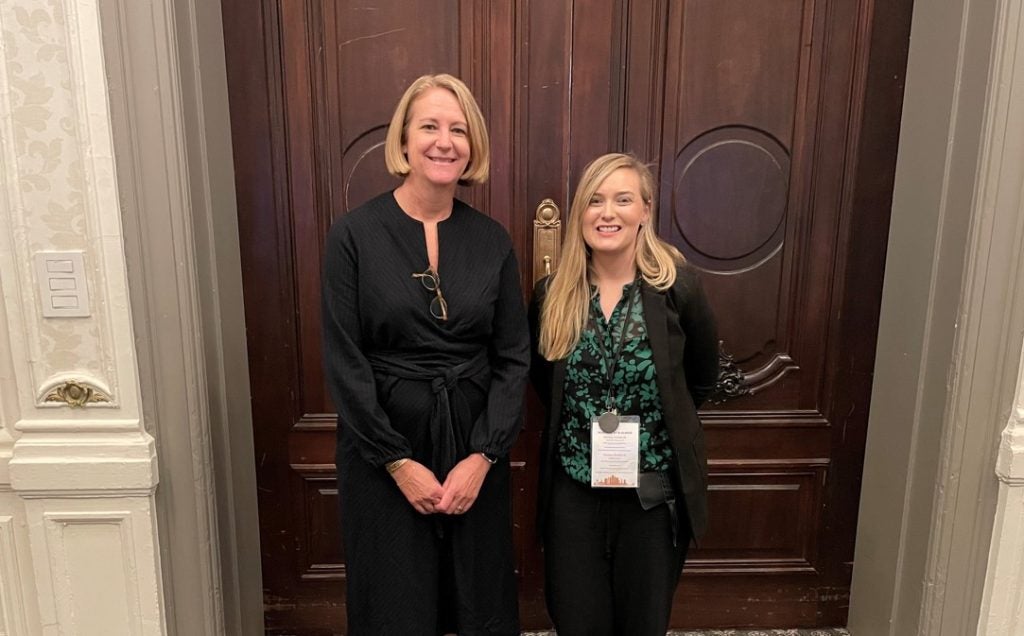The US is doing a "reset" on how it does trade policies with a focus on supply chain resilience Knight tells a live audience during her US Textiles and Apparel Industry Update at the World Fashion Convention in Philadelphia.
"We’ve been focused on advancing a worker-centric trade policy, rebuilding alliances and supply chain resiliency," she says, adding the US has a supply chain-specific work stream that includes specific working groups on anything relevant to security.
Knight reminds the audience that supply chain resiliency is a buzzword for not just the US but the world and in US commerce there's a big effort towards achieving it so "we've become the de facto supply chain analysis group".
She explains the newly launched supply chain group will work with industry deep divers, so it will have ongoing analysis that’s data-driven and will aim to identify choke points ahead of time.
Plus, there's an advisory committee on competitiveness and an agency taskforce on the cost and flow of domestic and international freight at shipping ports.
In a one-to-one with Just Style after her live session Knight explains that after the pandemic the US Administration realised it needed to focus on both its domestic and international supply chains: "It's about trying to get ahead of the game and it's an interesting and positive development".
Sustainability and circularity go hand and hand with any supply chain discussion, and Knight notes the Biden Administration does support sustainable and environmental practices with an overall goal to recycle at least 50% by 2030.
The US is also keen for its international sourcing regions to increase their product capabilities and focus on quality as well as sustainability, flexibility and speed to market.
There is a focus on growing the US domestic apparel manufacturing base as part of this drive for supply chain resiliency, however Knight is keen to note the country has free trade agreements with 20 other countries.
In terms of import share of textiles and apparel the US has seen a 31% decline for China, but Knight admits it will continue to be a large part of the supply chain.
She also tells Just Style the fashion supply chain is experiencing a real pivotal moment of change that could lead towards re-regionalisation or what some might dub 'nearshoring'.
Knight names the Dominican Republic–Central America–United States Free Trade Agreement or CAFTA-DR as a US free trade agreement that is well positioned to grow its market share.
Given the US wants to continue growing its own apparel and textile industry the nearby CAFTA-DR region ties in nicely with the Made in USA push.
She notes it "will never be China but it is positioned to take more market share from the western hemisphere consumer base".
Knight describes this as the "co-production supply chain" because CAFTA-DR growth has a positive impact on the US industry too: "We're making yarn and fabric and taking it to central America".
Of course, she openly admits the US can't do everything so there's lots of innovative business models and opportunities available in both the US and elsewhere.
The "big challenge," she adds, is that "over the last 30 to 40 years China has created a vertical industry, so "we've lost a lost a lot of those [vertical] capabilities on our side of the world".
On the plus side, she argues there are entrepreneurial opportunities available and "we're seeing that in central America so hopefully that will accelerate".
When asked directly about the HOPE/HELP trade programme for fashion sourcing nation Haiti and the benefits of its extension before it expires in 2025, she responds that it is a question for Congress.
However, she's happy to tell us: "For several brands and companies it's an important part of their sourcing portfolio so we’d like them to continue to have that option in the western hemisphere."
Similarly, when quizzed on the African Growth and Opportunity Act (AGOA), which gives eligible sub-Saharan African countries duty-free access to the US market and is also close to expiry, she states: "AGOA is small but it’s become a viable option for certain brands to take advantage of."
To help fashion brands and retailers source from the US the Office of Textiles and Apparel (Otexa) has a Made in the USA directory with 660 different companies producing domestically.
It ranges from finished products to suppliers so Knight regards it as a great starting point as it includes every part of the supply chain.
When asked about her predictions for the future Knight can't deny that we're still in a tough spot with lots of inventory that is not quite moving through the system.
But, she remains optimistic that by the second or third quarter of next year the sector will see a reversal of this trend with a small disclaimer that if there is any further geo-political downturns, this could of course have a negative impact in future.









